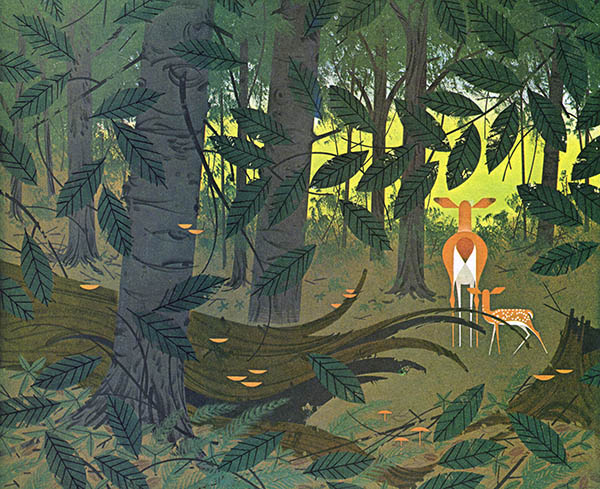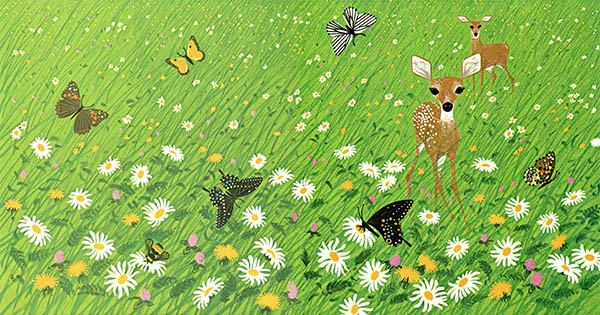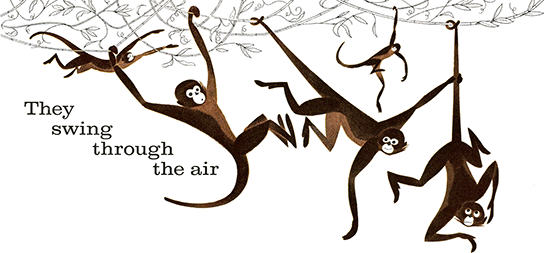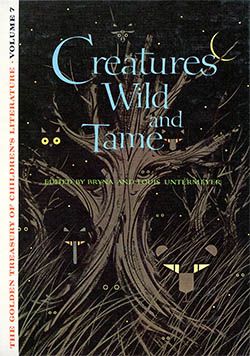Bambi and Childcraft
Charley Harper as Illustrator: the 1960s, part II
After the Golden Book of Biology, Charley didn’t have a hard time getting work as a children’s nature illustrator. During the 1960s he did several more projects for the Golden Press, a series of commissions for Field Enterprises and a public piece for the GSA.
In 1963 Charley illustrated the Bambi story for the Golden Press’ Creatures Wild and Tame:
Perhaps one of the reasons that Charley’s work is so enduring is how he treated his subject. As he stated in the mid-1970s: “I am careful to avoid anthropomorphism, having learned once when I illustrated “Bambi” that I am unalterably opposed to implying that animals act from the same motives and think the same thoughts as humans.” Compare the above to, e.g., Disney’s famous representation of Bambi and Charley’s respect for nature becomes rather obvious.
Around the time of his Bambi work Charley began freelancing for Field Enterprises, who published both the Childcraft Library and the World Book Encyclopedia. His illustrations first appeared in the 1964 edition of Childcraft2 and the 1966 edition of World Book, and were seen by an entire generation of school children. Here are some Childcraft examples:
Also in 1964 Charley completed a mural in the lobby of the new Cincinnati Federal Building.3 The mural, actually two murals, each 18' × 10.5', was titled American Wildlife and included more than 100 animals done entirely in ceramic tile and the occasional plastic strip. Mosaic turned out to be a perfect medium for Charley’s Minimal Realism, and the result is unmistakable. Here’s an image from an old promotional postcard:
1. Salten, Felix. “Bambi Finds the Meadow” in Creatures Wild and Tame (Untermeyer, Byrna and Louis, eds.) New York: Golden Press, 1963. The story (with Harper’s illustrations) was also included in The Golden Treasure Chest: Animal Stories. New York: Golden Press, 1968
2. Childcraft – the How and Why Library. Chicago: Field Enterprises Educational Corporation, 1964. Most of Charley’s illustrations are in volume 4, Life Around Us. In general the quality of illustration in the Childcraft Library is surprisingly good. In addition to Harper, the series also included illustrators such as Eloise Wilkin, William Steig, even Maurice Sendak. Harpers illustrations appeared in the Library as late as the mid-1970s, however for maximum mid-century goodness most experts recommend the 1964 edition.
3. This is but one of several murals and mosaics that Charley designed throughout his career. Here is the unabridged list: Michigan Wildlife, Ford General Staff Office Building (date ?); Transportation around the World, Ford Rotunda, (destroyed by fire, 9 Nov 1962); American Wildlife, John Weld Peck Federal Building, 1964; Spacewalk, Cincinnati Convention Center, 1967; and Tree of Life, Pearson Hall, Miami (Ohio) University, 1986.
Codex xcix (Home, About) is an occasionally updated weblog mostly about the history of visual arts and graphic design. For what this specifically entails, see the Archive.
Correspondance is always gratefully received. Follow your narrators’ fairly charmed life on Twitter.
This is the fourth post in a Charley Harper mini retrospective. Here is part I, part II and part III.
23 Sep 2009 ‧ Illustration












